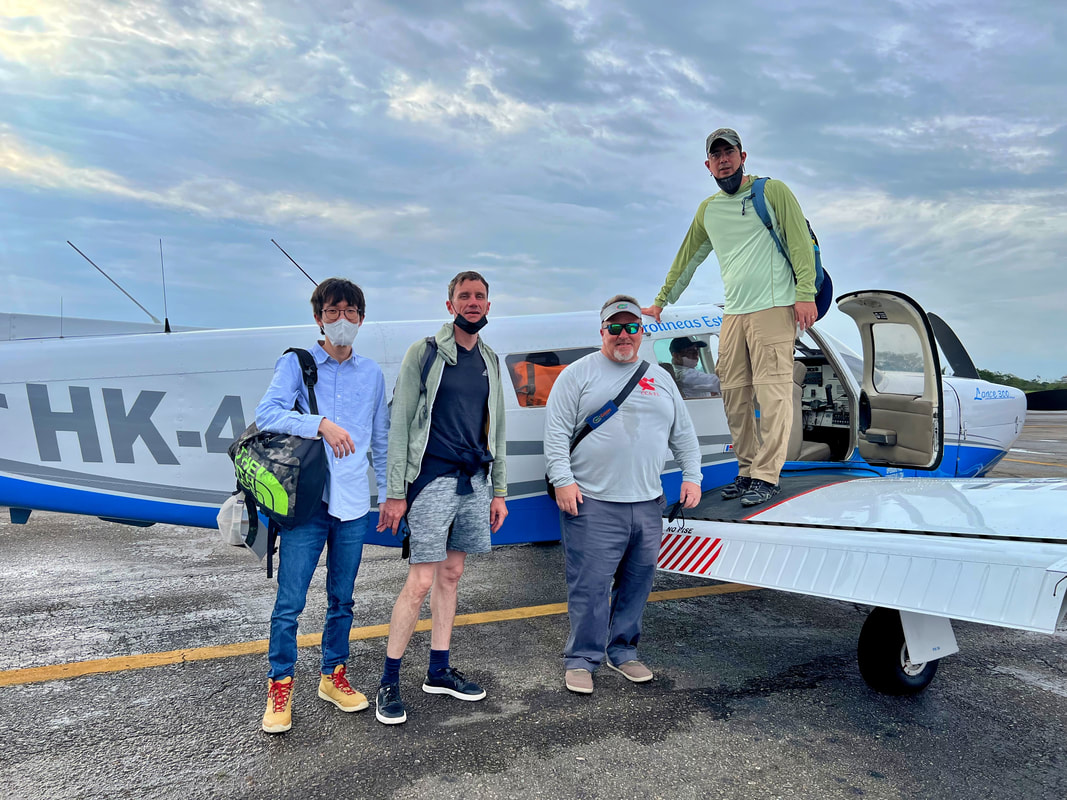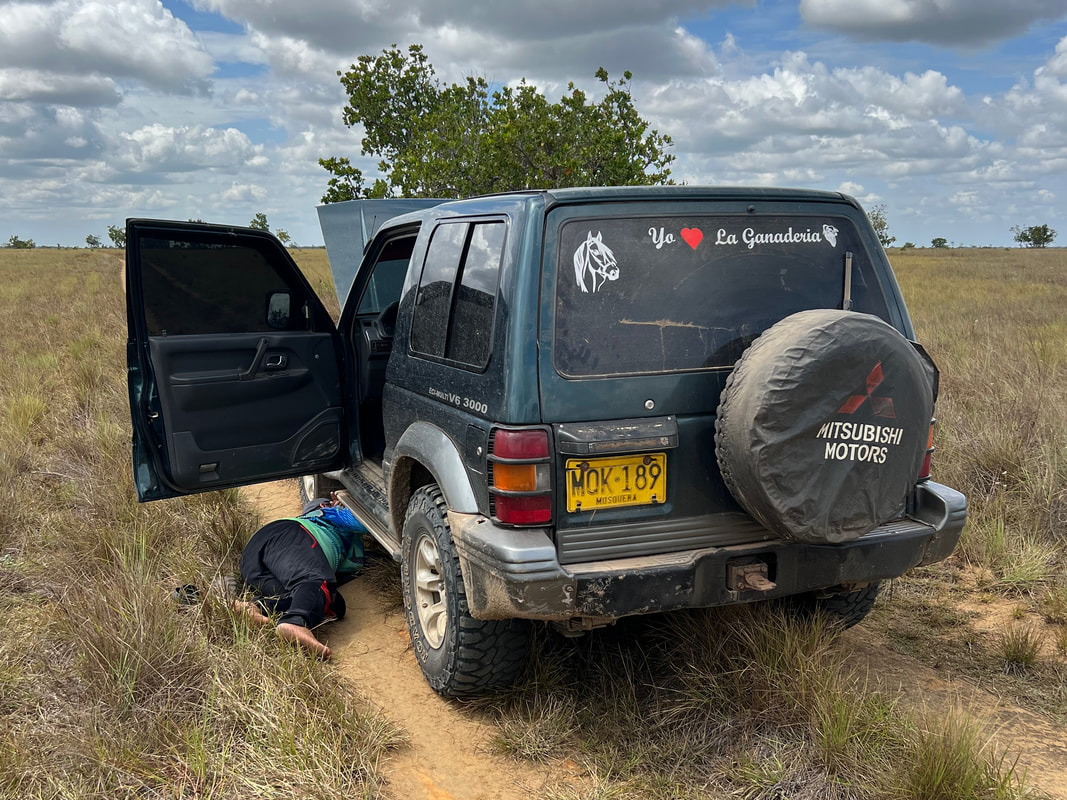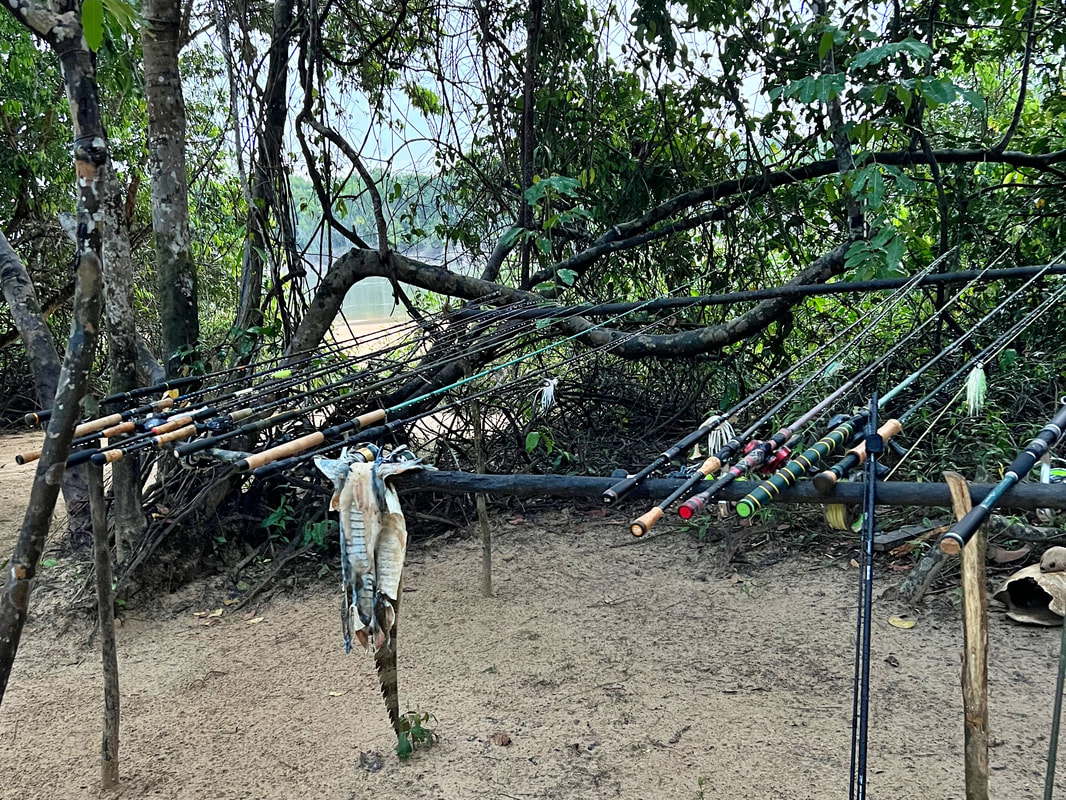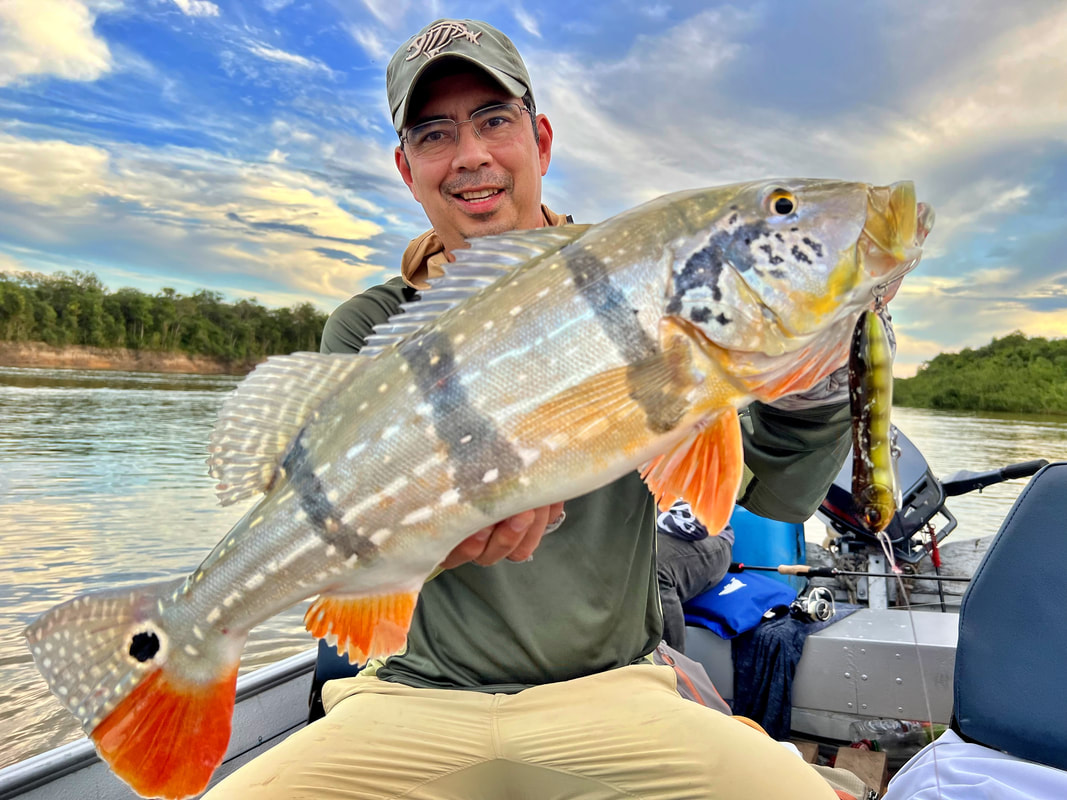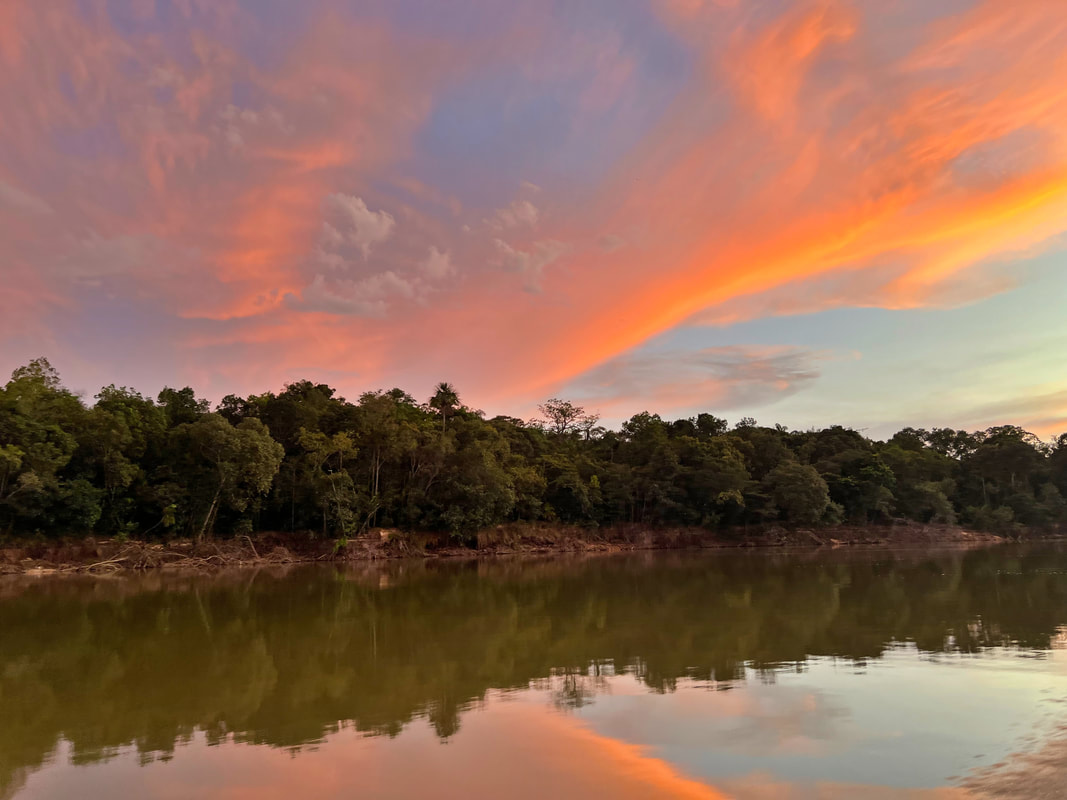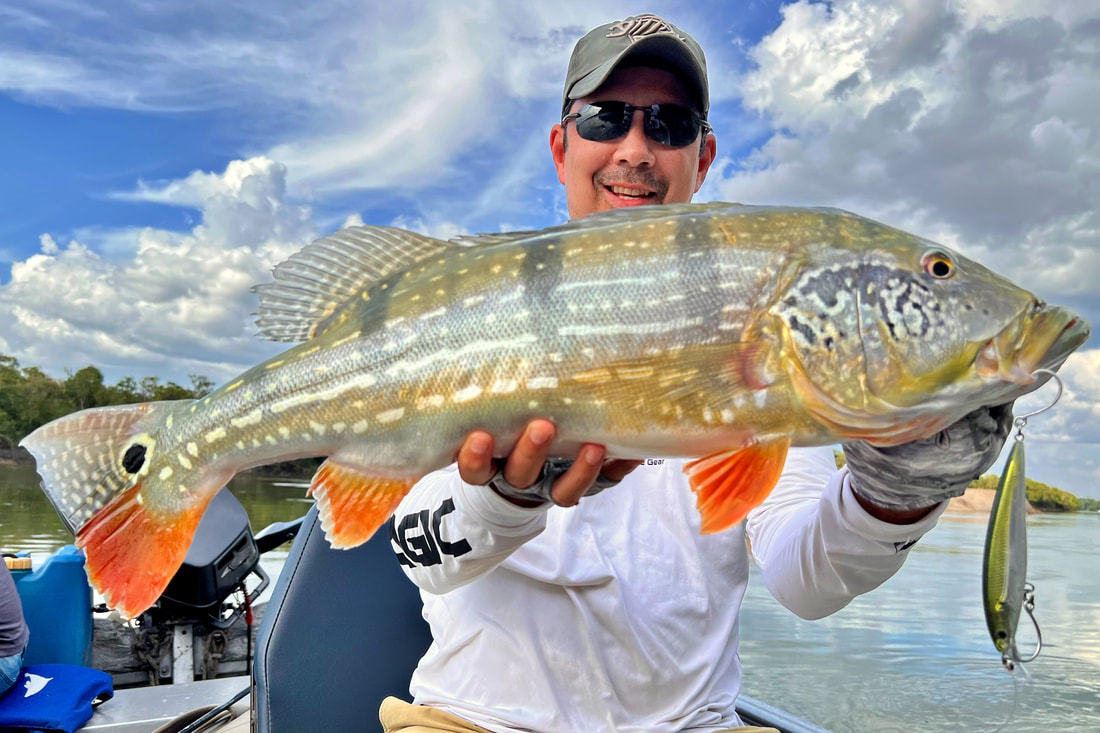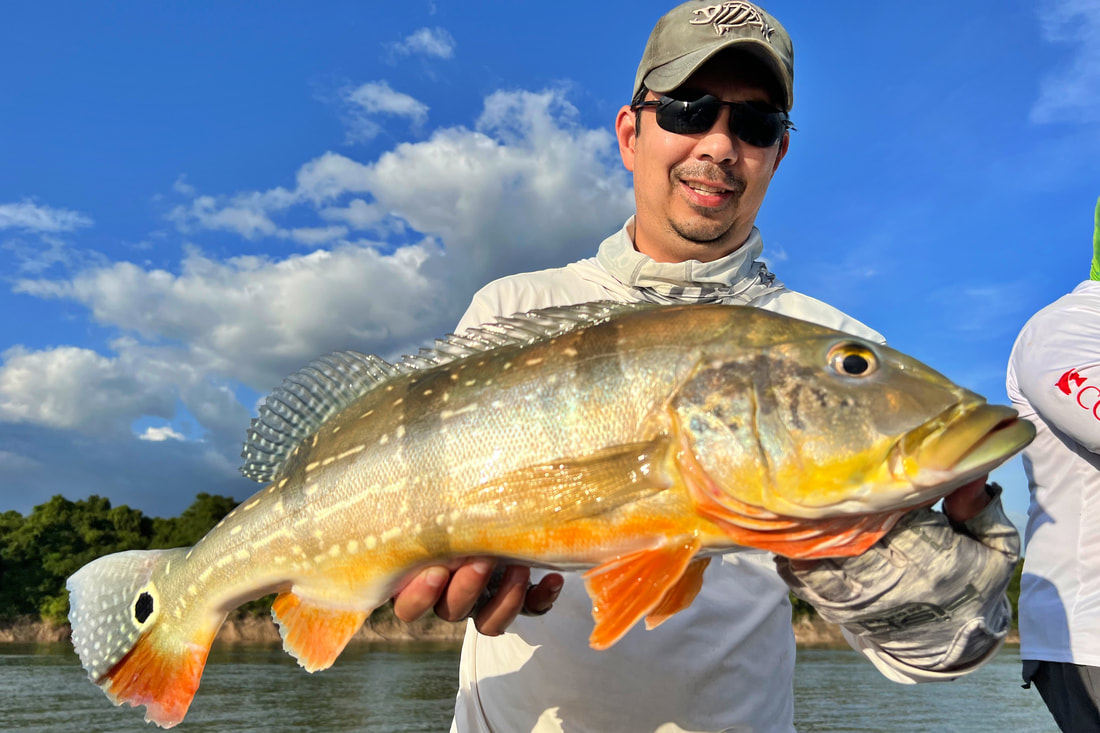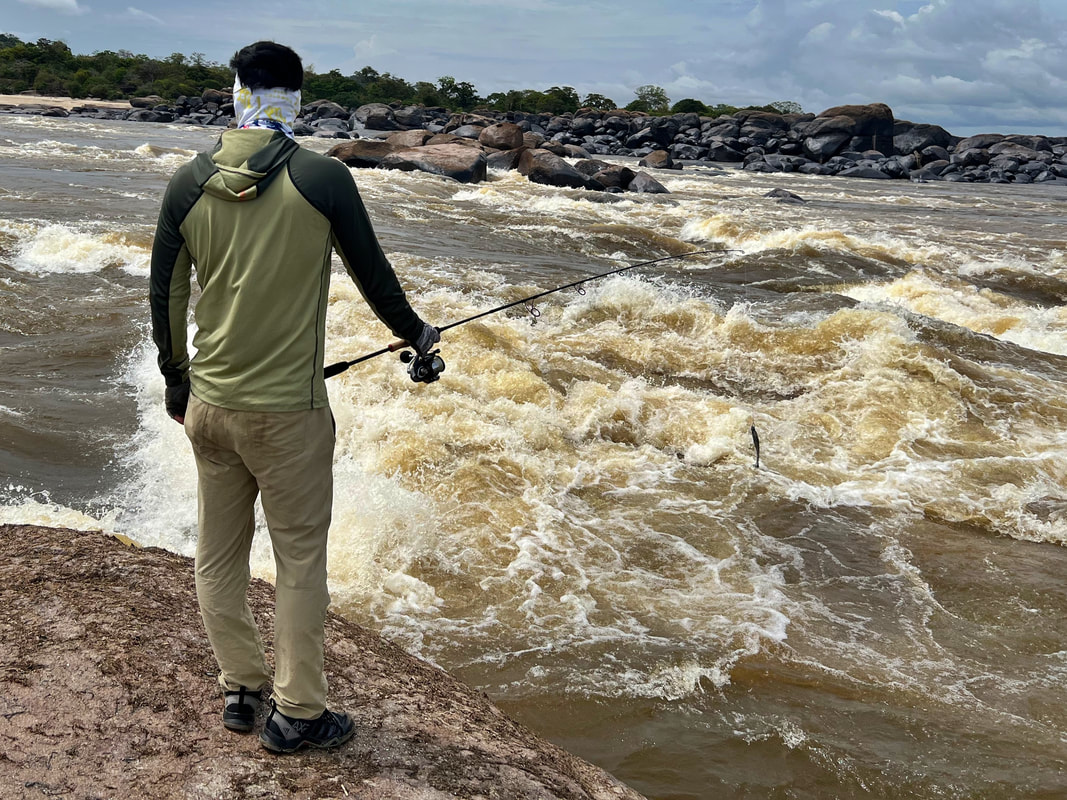Tomo River and Orinoco River, Colombia
January 2023
Colombia has had a bad reputation in the past, but it has clearly turned a corner from its darkest days in the 1990s with the cartel violence. This was my second trip there, and I never felt the least bit unsafe. It is a beautiful country with much to offer both on the water and off.
I chose Colombia because it is an outstanding destination for both Peacock Bass and Payara. There are very, very few places where you can fish for trophy-sized specimens of both species. I had the privilege to fish it through the excellent operator Fish Colombia (www.fishcolombia.com). As always, it was an adventure just getting there. It started with a flight to Bogota, and I got in late around 11pm. Just a few sleep hours later, we departed at 4am the next morning for a drive to the charter airport at Villavicencio. There we boarded a tiny plane and flew about 2 hours to the Llanos region of eastern Colombia. Thankfully the flight was smooth as I'm never a big fan of these small planes.
January 2023
Colombia has had a bad reputation in the past, but it has clearly turned a corner from its darkest days in the 1990s with the cartel violence. This was my second trip there, and I never felt the least bit unsafe. It is a beautiful country with much to offer both on the water and off.
I chose Colombia because it is an outstanding destination for both Peacock Bass and Payara. There are very, very few places where you can fish for trophy-sized specimens of both species. I had the privilege to fish it through the excellent operator Fish Colombia (www.fishcolombia.com). As always, it was an adventure just getting there. It started with a flight to Bogota, and I got in late around 11pm. Just a few sleep hours later, we departed at 4am the next morning for a drive to the charter airport at Villavicencio. There we boarded a tiny plane and flew about 2 hours to the Llanos region of eastern Colombia. Thankfully the flight was smooth as I'm never a big fan of these small planes.
We then boarded two SUVs owned by some local rancheros for a 1.5 ride to the river. This was the only portion of the logistics that didn't go smoothly, as one of the SUVs was in sad shape and must have broken down at least 10 times during the trip. When that happened, the other driver would pop the hood or go under the car and fiddle with things. He eventually figured out he could get it going again for at least a few hundred more yards if he poured water on something and then waited for 5 minutes or so. This worked for a while until we ran out of water. Fortunately, another ranchero happened by on a horse so they sent him off for more water. Eventually we got to the Tomo River and boarded the boats for the short ride to camp.
We got in a short session of fishing in the late afternoon and got a few small Peacock Bass, which whetted our appetites for more. The camp was rustic, but functional. We had large tents that were double occupancy and were connected to individual bathrooms and showers. The bathrooms were very basic, as there was no sink, mirror, hot water, etc in the bathrooms. There was also no roof on the bathrooms, which was annoying when it rained and also let in a plethora of insects. However, it was fine for a jungle camp. Crucially, the tents did have fans. The chef at this camp really went above and beyond and produced some surprisingly delicious dishes. Usually I don't think about the food at these places; I just eat to refuel. However, I was consistently pleasantly surprised with the creative dishes this guy came up with.
After the first night, we were joined in the camp by three German anglers who had been down at the Orinoco camp that Fish Colombia also operates about 10 hours away by boat. They told us of unbelievable Payara fishing where they were landing upwards of 100 fish per day. I was worried that type of wide open bite would not last, and was anxious to get down there. However, we would first be fishing the Tomo River for Peacock Bass for several days.
On day 1 I was paired with the Korean guy and we set out in search of some Peacocks. Things started a bit slow, with a little fish here and there, until he switched to a small bucktail jig and just starting whacking them in a nice lagoon off the main river. It was such a small jig that I figured he would just get small ones, so I stuck to my Rapala X-Rap. However, the numbers he was racking up were getting hard to ignore, and when he got a beautiful 14lber I decided to switch tactics. I didn't bring any bucktail jigs, but I had brought a lot of flies and some bullet weights for just this eventuality and so I put that on and started whacking them too. My best fish was a 10lber and I got a number of 6-9lbers. By the end of the day I ended up with 32 and he got 46 for a good numbers day.
On day 1 I was paired with the Korean guy and we set out in search of some Peacocks. Things started a bit slow, with a little fish here and there, until he switched to a small bucktail jig and just starting whacking them in a nice lagoon off the main river. It was such a small jig that I figured he would just get small ones, so I stuck to my Rapala X-Rap. However, the numbers he was racking up were getting hard to ignore, and when he got a beautiful 14lber I decided to switch tactics. I didn't bring any bucktail jigs, but I had brought a lot of flies and some bullet weights for just this eventuality and so I put that on and started whacking them too. My best fish was a 10lber and I got a number of 6-9lbers. By the end of the day I ended up with 32 and he got 46 for a good numbers day.
After a strong first full day I thought we would have them dialed in, but the next day started extremely slow. I was fishing with the American guy and I only had one small fish in the boat in the morning and he maybe had 2. It was extremely tough. Our guide Nick was wracking his brain for ideas, but sometimes they just don't bite. Fortunately, the day was saved by a good late afternoon bite on the sandy beaches. Walk the dog lures resulted in some enormous topwater explosions from good-sized fish. Any time a Peacock over about 8lbs bites a surface lure, it sounds like someone dropped a washing machine into the water. That's why people head to the jungle to fish for them and that's a big reason why they are my favorite freshwater fish. One nice aspect of the beach fishing was that there were no rocks, trees, or other obstructions to worry about once they were hooked. You could just enjoy the fight and land most of the fish. It was a really beautiful setting and time of day, and it certainly didn't hurt that the fish were biting. Great end to what had been a hot and frustrating day.
The next day I was partnered with the French guy. We hit up the lagoon from the first day and starting picking up fish, with lots in the 5-8lb range. We had each landed a dozen by lunch. After lunch it was slow for a bit, but the late afternoon beach bite was on again and my trusty Imakatsu Trairao was getting blown up in spectacular fashion. I lost a 12lber right at the boat when it spit the hooks, which bummed me out a lot for about 10 minutes until I was able to hook and land a much bigger fish. This was the biggest Speckled Peacock (a color phase of Cichla temensis, the largest Peacock Bass species) I had ever seen. We didn't weigh it as I wanted to take pics and release it quickly so it wouldn't get eaten by the dolphins that were always following us around, but the guide estimated it at 14-15lbs. It was an extremely long fish. The French guy got a blowup from another fish that was with my big one, but was unable to hook it. I think he was a bit stunned by the size of the explosion and just stood there staring instead of continuing to move the lure. You really have to keep your wits about you when fishing topwaters for these fish. I landed another 8lber and then we ran out of daylight.
The next day we moved from our camp to another camp farther downriver. I was paired up with the Korean guy again, and he decided he didn't want to fish for small ones so he either just rested or furiously threw a big noisy prop bait until he couldn't do it anymore and would take another break. He got one small one and then late in the afternoon got a huge blowup and landed a beautiful 16lber. With that he was done for the day. I opted for more action, so I fished the fly a lot and landed 24 small to midsized fish. I had a big fish charge the fly and I foolishly pulled it away too quickly when I thought he had taken it. Unfortunately we didn't get to fish the prime 4-6pm window because we were traveling that day and had to get past a certain point by a certain time.
The highlight of the day was seeing an Anaconda. It was mostly submerged, with just its head above water, but I could see the body in the water. It looked about 8ft long. It took off after seeing us; I guess it saw we didn't have any buns. That's the first time I've seen one in the while. We also saw a Giant River Otter, which ignored us.
The mid river camp was built pretty much identically to the first camp. Unfortunately there were several other operations in the area, and we saw a lot of boats. Peacocks don't respond well to that amount of pressure, so we didn't bother fishing close to that camp. The next morning we headed further downriver towards the Orinoco camp, fishing along the way. I was paired with the American guy that day. A few hours away from camp, away from the other operations, we found a beautiful lagoon. I was throwing the big prop lure in hopes of getting a giant, and got a couple of huge blowups with no hookup upon entering the lagoon. A little later I got a huge blowup that actually stuck, and after a nail-biting fight I got this 17lb beauty into the boat.
The highlight of the day was seeing an Anaconda. It was mostly submerged, with just its head above water, but I could see the body in the water. It looked about 8ft long. It took off after seeing us; I guess it saw we didn't have any buns. That's the first time I've seen one in the while. We also saw a Giant River Otter, which ignored us.
The mid river camp was built pretty much identically to the first camp. Unfortunately there were several other operations in the area, and we saw a lot of boats. Peacocks don't respond well to that amount of pressure, so we didn't bother fishing close to that camp. The next morning we headed further downriver towards the Orinoco camp, fishing along the way. I was paired with the American guy that day. A few hours away from camp, away from the other operations, we found a beautiful lagoon. I was throwing the big prop lure in hopes of getting a giant, and got a couple of huge blowups with no hookup upon entering the lagoon. A little later I got a huge blowup that actually stuck, and after a nail-biting fight I got this 17lb beauty into the boat.
The American guy started fishing a prop bait hard and got some nice blowups that didn't stay hooked. I decided to switch to an XRap as the morning wore on because I figured the fish would go deeper, and that worked really well. I got a beautiful 13lber casting out to the middle of the lagoon near some boils.
We continued to fish the lagoon and I continued to stick fish. No giants, but very few small ones either. After that we headed down quite a ways until we got to some large rocks in the middle of the current. I saw a big fish blowup on a bait at the far end, so I tied the prop bait back on and started it ripping it loudly over the rocks. After a few casts I stuck a nice 8lber, then the American guy hooked a big fish that broke him off in the rocks, then I hooked a bigger fish that wrapped me around a log but that I luckily managed to land. When the topwater bite died down I went back to the X-rap and stuck some more. None of these fish were huge, but again none were small. I finished the day with 23 Peacocks landed, with by far the largest average size of any day on the trip. That brought my total number of Peacocks landed to 101 for the trip, and I didn't catch any more after that as we switched to Payara. Fantastic day despite spending about 5 hours of it traveling rather than fishing. Below are some of the solid afternoon fish.
We reached the Orinoco camp after dark. The Orinoco is a much larger river than the Tomo, and forms the border with Venezuela in some sections. Simon Bolivar, Liberator of South America, apparently stayed there at some point, and there is a big statue of him somewhat randomly given how sparsely populated the area is.
The Orinoco camp was the least rustic of the three camps. It had permanent structures. It theoretically had Wi-Fi, but I was only able to get it to sporadically receive or send a text or two. Unfortunately there were a lot of mosquitoes, although none of the sandflies that had plagued us on the Tomo. Here are a few pics, including one of the friendly camp dogs.
We left camp the next morning with high hopes of hundreds of Payara bites like the other group had a few days earlier. First we picked up a local Sikuani Indian from Venezuela. Fish Colombia has a good relationship with the Sikuani, providing jobs and other things in exchange for permission to fish. We went up some rapids (with life jackets on for safety) and got dropped off at some rocks near the rapids to start casting. Here is what the first rock looked like.
Almost immediately, the Korean guy and I were rewarded with a flurry of bites. Expecting a day of nonstop action, I was probably a little too casual about playing the first few fish. One of them jumped and spit the hook, another got under a rock near my feet and cut the line, and another straitened a hook that was probably too thin to be using. We each landed a small Payara though.
Unfortunately, the bite tapered off. We tried several spots, some from on foot (which often required some rock climbing) and some from the boat. Each produced a bite or two, but that was all. With Payara you only land a relatively small percentage of the bites you get due to their bony mouths, so to land a lot of fish you really need a lot of bites, which we weren't getting. By lunch the bite died completely and didn't pick up until late afternoon.
Around 330 we found a small spot that produced some bites. The Korean guy and I each landed double digit fish at that spot, and he went on to land some more small ones while I went on to lose quite a few. Only two Payara landed for the day for me.
The next day I was on my own, as the Korean guy had opted to rest and the other two guys went back to the first river to try for Peacocks. We started out at the first spot and unfortunately the water had risen and gotten dirtier from rains. Not good for fishing, although we had more sun which my guide indicated is good for Payara. Like the first day, bites were immediate first thing in the morning. After missing a couple short bites I switched to an articulated fly and on the first cast hooked up with a screamer on my light rod. It's hard to describe the bite of a big Payara - one minute you are slowly retrieving your lure near the bottom, and then in a second it feels like your rod got struck by lightning. I knew it was a big fish, and that if it made it to the main current it would head to China. I put as much side pressure as I could muster with the light rod in order to pull it away from the main current. Once I had it in the middle, I decided to try to tire it out before trying to land it because of the rocks near my feet. This worked well, because once I did bring it close it made a dive for the rocks but fortunately couldn't quite get there. It was a long and nerve-wracking battle, but I got the fish to the rock I was standing on. We weighed it (17lbs), took a couple pics, and quickly released it.
At that point I was feeling like my day was made, but I kept casting and hooked a few more and landed two more before the bite slowed and we went looking. I lost a big fish at another spot and then we stopped for lunch. Since this was the seventh straight day of fishing in the hot tropical sun, I was a little beat and decided to take a longer lunch and a short siesta since the fish were not biting well during midday.
After an extended break, I hit things hard again at around 3. There weren't many bites, but I picked up another small one.
We went to a small spot with rapids on both sides and lots of rocks. It didn't look like much, but I got a huge bite right away. It headed to the rapids on one side but I managed to pull it out, and then it went to the rapids on the other side and I somehow pulled it out of there. I had it to my feet, but the guides were having trouble landing it with the Boga in the fast current. With a net we would have had it, but it eventually made a last dive and straightened the hook. I was gutted as I got a very good look at the fish and it was much bigger than the 17lber from earlier. I figured that was the only big fish in such a small spot, but a couple casts later I got another big bite and lost that one when it jumped and spit the hook. After that I got another bite and it went into the rocks but I managed to maneuver it out. I was surprised to see it was not a Payara. The guide called it a Bocon but it looks like a Matrinxa to me.
I got dusted by another nice Payara and then it was time to leave. The Payara really humbled me that afternoon, but that's fishing.
The trip back was long and hot but uneventful. We took a commercial flight out of Puerto Carreno, which unfortunately is overrun with Venezuelan refugees. Hopefully things improve for that country soon.
Fish Colombia did an amazing job with the logistics; there are a lot of moving parts. Our guides were fantastic and all the staff were very friendly. They seemed genuinely concerned on nights when we didn't eat much (due to the heat not the food quality). The only downside was the bugs, and obviously there was nothing Fish Colombia could do about those. They were a minor annoyance, and the trip was well worth it. I can't wait to head back to the Colombian Amazon.
The trip back was long and hot but uneventful. We took a commercial flight out of Puerto Carreno, which unfortunately is overrun with Venezuelan refugees. Hopefully things improve for that country soon.
Fish Colombia did an amazing job with the logistics; there are a lot of moving parts. Our guides were fantastic and all the staff were very friendly. They seemed genuinely concerned on nights when we didn't eat much (due to the heat not the food quality). The only downside was the bugs, and obviously there was nothing Fish Colombia could do about those. They were a minor annoyance, and the trip was well worth it. I can't wait to head back to the Colombian Amazon.

